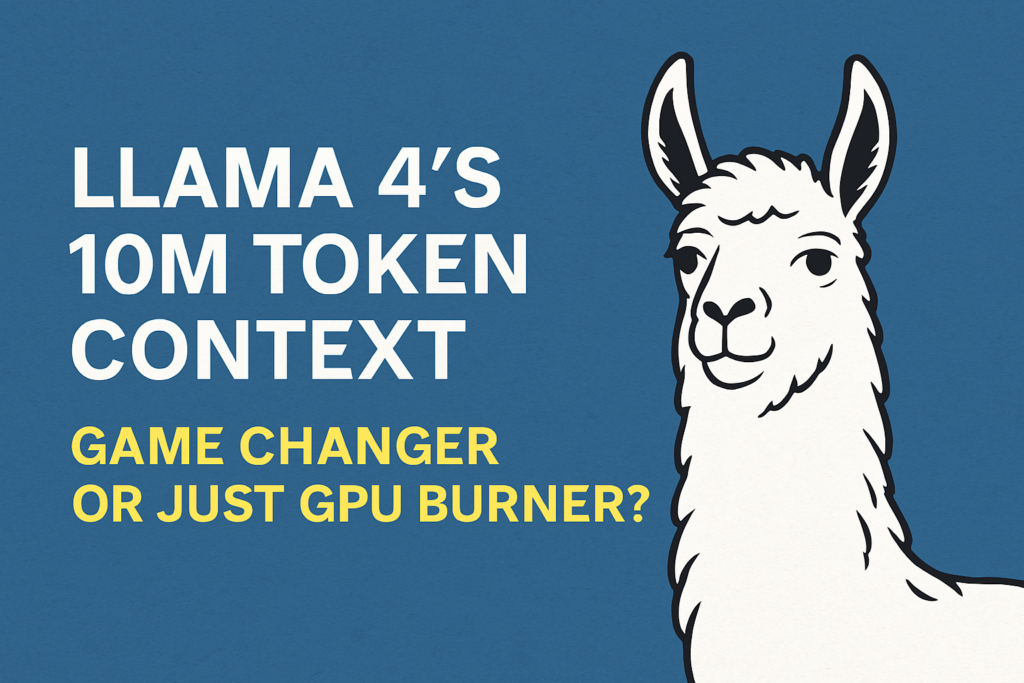When Meta teased that Llama 4 could support a 10 million token context window, the AI world raised its eyebrows. That’s a serious leap in what large language models can ingest and reason about in one go.
But here’s the real question:
Is this a revolutionary upgrade?
Or is it just a bigger, slower prompt that costs a fortune to run?
Let’s break it down—practically, realistically, and from a product builder’s point of view.
What Is a 10M Token Context Window?
A token is roughly 0.75 words. So 10 million tokens equals about 7.5 million words.
That’s equivalent to:
- 100 full-length novels
- 10,000+ Wikipedia pages
- An entire monorepo of source code with documentation
- A full year of meeting transcripts or customer support chats
Picture 30,000 pages of printed text, stacked 10 feet tall—and your AI assistant can “read” it all at once.
That’s not just a party trick. It opens up new types of reasoning that weren’t feasible before.
When 10M Context Actually Matters
This isn’t about generating longer outputs. It’s about letting the AI reason more effectively, with full visibility across everything that matters.
Here are real-world scenarios where 10M context is a game changer:
- Feeding in your brand guide, full blog archive, product catalog, and customer persona sheets to generate consistent, on-brand website content
- Analyzing and comparing 20 contracts to identify conflicting clauses
- Refactoring an entire codebase and tracing how changes ripple through dependencies
- Summarizing 6 months of call transcripts and identifying recurring pain points
- Training an AI agent with all company onboarding material, historical decisions, and documentation—no retrieval system required
These use cases were previously impossible to solve cleanly. Now, they’re within reach.
Where It Doesn’t Deliver
Let’s be clear: a massive context window won’t make your support chatbot smart.
And it doesn’t automatically solve hallucination, poor focus, or reasoning errors.
In fact, if you load in 10 million tokens of unstructured junk, the model may just drown in irrelevant noise.
Real limitations:
- High latency (we’re talking seconds, not milliseconds)
- Expensive inference (especially if you’re operating at scale)
- Requires huge compute resources (often multiple 80GB GPUs)
- Still needs intelligent structuring of context (models don’t inherently know what to focus on)
You don’t just “use” a 10M context window—you architect around it.
RAG vs 10M Context: Which One Wins?
This isn’t an either/or situation. Retrieval-Augmented Generation (RAG) is still the most efficient and scalable solution for most everyday tasks.
But there are clear situations where 10M context shines and RAG falls short.
| Use Case | Best Fit |
|---|---|
| Chatbot FAQ | RAG |
| Strategic business planning across multiple sessions | 10M Context |
| Generating a web component based on user input | RAG |
| Creating a fully-branded, multi-page website | 10M Context |
| Answering simple customer support queries | RAG |
| Comparing and synthesizing multiple documents | 10M Context |
RAG is best when you need fast, lightweight, precise responses.
10M context is best when the AI needs total visibility to reason, plan, or generate with contextual cohesion.
Real Example: AI Website Builder
Let’s say you’re building a smart AI website builder.
With a 10M context window, you can give the model:
- Your full brand style guide
- 500 reusable components
- 20 example sites for inspiration
- Uploaded content from the customer (logos, headlines, testimonials)
- Analytics reports
- Sitemap and navigation plans
Then you ask:
“Generate a 5-page website that matches our tone, reuses existing components, and adapts to mobile. Include metadata, accessibility, and a rationale for your layout choices.”
All of that can happen in a single prompt, with zero retrieval required.
This level of global awareness and reasoning? Previously impossible. Now, a real competitive edge.
So, Is It a Game Changer?
Yes—if you’re solving problems that involve complexity, scale, or long-range reasoning.
No—if you’re optimizing for speed, cost, or just trying to build a solid chatbot.
You don’t need 10 million tokens to answer:
“Where’s my order?”
But you do need it to answer:
“Across our last 6 months of call logs, product reviews, and behavior data, what are the top churn drivers—and how should we address them in our onboarding flow?”
Final Takeaway: Use the Right Tool for the Right Depth
RAG and long-context are not enemies—they’re tools for different levels of depth and complexity.
Use RAG when:
- You want targeted answers from large knowledge bases
- Speed, scale, and cost are critical
- You want precise control over what the model sees
Use long context when:
- You want rich, global reasoning
- You’re comparing across documents, versions, or interactions
- You’re building planning assistants, strategic advisors, or long-memory agents
10M context is a real innovation.
But it’s not for everyone—and it’s not for everything.
It’s not just a longer prompt. It’s a new kind of AI capability.
